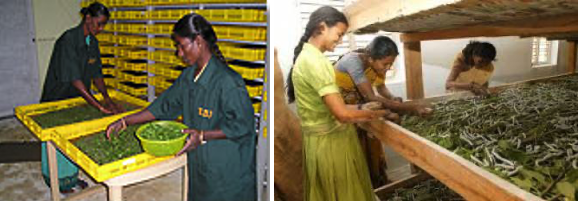🥻 Introduction
Learn about silk farming & sericulture industry
Which of the following statement is correct?
Sericultureor silk farming, is the cultivation of silkworms, includes breeding and management, to produce raw silk on commercial scale.- The word ‘Sericulture’ is derived from the Greek ‘sericos’ meaning ‘silk’ and the English ‘culture’ meaning ‘rearing’.

- Sericulture is an
agro-based industry. - Silkworm rearing are agriculture in nature whereas silk reeling, silk twisting and weaving activities are industrial in nature.
- It involves rearing of silkworms for the production of raw silk, which is the yarn obtained out of cocoons spun by certain species of insects.
- The major activities of sericulture comprises of food-plant cultivation to feed the silkworms which spin silk cocoons and reeling the cocoons for unwinding the silk filament for value added benefits such as processing and weaving.

Silk
- Natural Silk is insect fibre. It comes from the silkworm cocoon that the silkworm spins around itself to form its cocoon.
- The silk is
protein filamentwhich is secreted from the salivary gland of the larva of silkworm. - A single filament from a cocoon can be as long as 1600 meters.
- It is considered an animal fibre because it has a protein structure.
- Just like other animal fibres silk does not conduct heat, and acts as an excellent insulator to keep our bodies warm in the cold weather and cool in the hot weather.
- Chinese Empress Shiling Ti discovered it in her tea cup.
- The Chinese were extremely protective of the process for making silk which was an integral component of their economy. Entire villages in China were dedicated to silk production. Over time, however, the closely guarded secret was divulged, and by the second century C.E., silk production had spread to India. Subsequently, Japan also began producing silk a few centuries later.
- Silk is the most elegant textile in the world with unparalleled grandeur, natural sheen, and inherent affinity for dyes, high absorbance, light weight, soft touch and high durability and known as the
Queen of Textilesthe world over.
Status
- The textile sector generates the second-largest employment.
- Sericulture industry provides employment to approximately 8.25 million persons in rural and semi-urban areas in India during 2015-16.
- India has the unique distinction of being the only country producing all the five known commercial silks, namely, mulberry, tropical tasar, oak tasar, eri and muga, of which muga with its golden yellow glitter is unique and prerogative of India (finest and expensive).
Chinastands in first position in Global Silk Production with 68,600 MTs (2019-20).Indiastands at 2nd place with 36,152 MTs.Karnatakaproduces 11,143 MTs of raw-silk (1st place in the country, 2019-20) followed by Andhra Pradesh with 7,962 MTs followed by Tamil Nadu with 2,154 MTs, followed by Telangana with 297 MTs.- Mulberry sericulture is mainly practiced in five states namely,
- Karnataka
- Andhra Pradesh
- Tamil Nadu
- Assam
- West Bengal
- Jharkhand
- Northeast has the unique distinction of being the only region producing four varieties of silk viz., Mulberry, Oak Tasar, Muga and Eri. Overall NE region contributes 18% of India’s total silk production.
- Among the four varieties of silk produced in 2015-16, Mulberry accounts for 71.8%, Tasar 9.9%, Eri 17.8% and Muga 0.6% of the total raw silk production.
Indiais the largest consumer of silk in the world.- Silk city of India:
Bhagalpur, Bihar which is considered as one of the biggest trade centre of Eastern India is famous for its unique silk fabrics called “Tussah or Tusser” which is why it is called the silk city of India.
Institutes
- Central Silk Board comes under Ministry of Textile, situated at
Bangalore. - Central Silk Technological Research Institute, Bangalore
- Central Sericultural Research and Training Institute (CSRTI), Mysore
Importance
- Sericulture is ideally suited for improving the rural economy of the country, as it is practiced as a subsidiary industry to agriculture.
- Recent research has also shown that sericulture can be developed as a highly rewarding agro-industry and can be utilized for a tool for rural reconstruction.
- High employment potential: labour intensive and high income generating industry.
- Provides vibrancy to village economies
- Low Gestation, High Returns
- Women friendly Occupation
- Ideal Programme for Weaker Sections of the Society
- Eco-friendly Activity
References
- https://csb.gov.in/
- https://agritech.tnau.ac.in/
- Wikipedia
- https://sericulture.assam.gov.in/
- https://agritech.tnau.ac.in
Which of the following statement is correct?
Sericultureor silk farming, is the cultivation of silkworms, includes breeding and management, to produce raw silk on commercial scale.- The word ‘Sericulture’ is derived from the Greek ‘sericos’ meaning ‘silk’ and the English ‘culture’ meaning ‘rearing’.

- Sericulture is an
agro-based industry. - Silkworm rearing are agriculture in nature whereas silk reeling, silk twisting and weaving activities are industrial in nature.
- It involves rearing of silkworms for the production of raw silk, which is the yarn obtained out of cocoons spun by certain species of insects.
- The major activities of sericulture comprises of food-plant cultivation to feed the silkworms which spin silk cocoons and …
Become Successful With AgriDots
Learn the essential skills for getting a seat in the Exam with
🦄 You are a pro member!
Only use this page if purchasing a gift or enterprise account
Plan
Rs
- Unlimited access to PRO courses
- Quizzes with hand-picked meme prizes
- Invite to private Discord chat
- Free Sticker emailed
Lifetime
Rs
1,499
once
- All PRO-tier benefits
- Single payment, lifetime access
- 4,200 bonus xp points
- Next Level
T-shirt shipped worldwide

Yo! You just found a 20% discount using 👉 EASTEREGG

High-quality fitted cotton shirt produced by Next Level Apparel